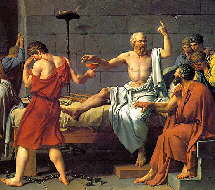April 6, 2012
Though crucifixion and resurrection myths have been quite popular in the cultures of Judeo-Christian heartlands before they became "Judeo-Christian" heartlands, the world has come to celebrate this wonderful story these days entirely attributed to Jesus Christ. Osiris and Dionysus who underwent similar three day ordeals have all been sublimated and incorporated into the tale of Christ.
In comparison, Socrates's hemlock was rather effective. But I am sure having been familiar with the plays on Dionysus, Plato might have double checked on Socrates' grave on the third day!
Interesting article in today's Manorama newspaper reflects Easter weekend's transformation into a consumerist affair. Mutton price has doubled in the city since last Easter says the report. It stands at 400-420 rupees per kilo. Though not as drastic, other meats are also dearer. The spike is attributed to the increased demand for Kerala mutton in the middle East. Apparently, the Malayalees in Dubai insist on eating goats from back home!
Not that the local demand is any less. Even though the bi-annual "Aarattu" procession of the Padmanabhaswamy temple falls on this Good Friday, I don't think many Hindus are inspired to swear off meat for the weekend. The Aarattu festival takes the miniature idols of Padmanabha, Krishna and Narasimha to the beach at Shanghumukham where they are immersed and brought back. The royal family and some elephants lead the procession. It should be interesting to find out if such immersions inspired Bal Gangadhar Tilak in the last century to come up with the Ganesh festival immersions that have become immensely popular with Mumbaikars ever since.
Besides, Jesus and Padmanabha, Vardhamana Mahaveera also had a significant date this week. His birthday was celebrated yesterday by the Jains. The 24th and last Thirthankara (meaning the one who helps cross or has crossed the river of life's sorrows)Mahavira was a contemporary of Buddha though I have never read anywhere about their having met. Closer to our times, Osho Rajneesh and Jiddu Krishnamurti never met though they were in nearby cities both in US and in India many times. When asked once what he thought of meeting Krishnamurti, Osho remarked that they would have nothing to talk about because they understood each other completely.
I guess Mahavira and Buddha might have had similar sentiments about a meeting though they have come to be considered as competitors, both of whom had vehemently and, in Buddha's case, sarcastically, opposed the prevalent, animal-sacrificing, orthodox Brahamanism as well as fatalist preachers like Malimat. Back in the days when I used to be engrossed in history of religion, I had read something about Malimat's cult giving stiff competition to both Buddha and Mahavira in northern India. A die-hard fatalist (haha!) Malimat used to carry a ball of string that he would let roll till it reaches the end to illustrate that human life is completely determined by fate which has already decided when our time, like the string, would run out. That's pretty much all I remember and having written that I am no longer sure if the name is Malimat and googling is not helping!
However, I am sure of the names of two other grand philosopher-spiritualist friends who spent time together in the wordlessness of complete understanding, Shams of Tabriz and Jalal-ud-din-Rumi, that 'Roman' poet of Anatolia!
In one of the last books on Jainism that I had browsed through in the Evans library couple of years ago, some new research was linking Rishaba, the first Thirthankara Jains with the 'Pashupati' Indus Valley seal. Plausible since Rishabham means bull and the seal shows a prominently 'horny' man in yogi pose. If we go back 24 generations from the time of Mahaveera, we do get close to Indus Valley civilization's estimated time period. In fact yogi-king is the ideal of Jainism, like the priest-king of Semitic religions and warrior-king of latter day Hinduism. I am tempted to say that the complete submission of the Travancore kingdom to the Lord Padmanabha by Marthandavarma was akin to a move from the warrior-king paradigm to the yogi-king model of ruling.
"Rishabam" reminds me that in Philip Lutgendorf's priceless "Hanuman's Tale", the Vedic icon of "Vrisha-kapi" i.e. Bull-Monkey is mentioned. Indrani, the wife of Indra, the king of gods (Devas) teases him for being jealous of the extremely virile and macho Vrisha-Kapi who represented the natives of the land to which the Devas had arrived. I had an interesting discussion on Vrisha-Kapi and the masculine insecurity that remains a constant undercurrent in global myths with Luis Valdez, the father of Chicano theater and director of Zoot Suit, when he had visited A&M as part of Hispanic week three or four years ago. We were walking to the Rudder building for lunch after he had delivered a theatrically charming, information packed lecture on Aztec mythology.
In the conflict between Tezcatlipoca and Quetzalcoatl that he had narrated with a Griot-like passion, there were unmistakable shades of the conflicts of Vrishakapi-Indra, Bali-Sugriva, Bali-Rama, Rama-Ravana and so on.
For all their world-beating, chest-thumping antics, mythological heroes seem all too vulnerable around the opinion of women, be it the wives, sisters or mothers....all too human! Crucifixion!



No comments:
Post a Comment